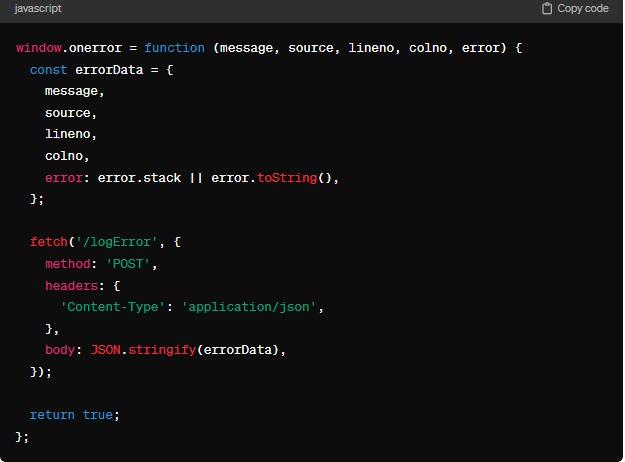Title: Leveraging Robust Error Handling in JavaScript: A Guide to Catching and Sending Errors to the Server
Introduction:
JavaScript is a versatile and powerful programming language widely used for building dynamic and interactive web applications. However, like any language, it is not immune to errors. Effective error handling is crucial for maintaining a smooth user experience and debugging issues during development. In this article, we'll explore the importance of catching JavaScript errors and sending them to the server for comprehensive error tracking and analysis.
Errors in JavaScript can occur for various reasons, such as invalid user input, network issues, or unexpected server responses. Without proper error handling, these issues can lead to broken functionality, poor user experience, and frustration for both developers and end-users.
To address these challenges, developers often implement client-side error handling to identify and manage errors gracefully. However, relying solely on client-side error handling has limitations. Not all errors may be captured, and users can manipulate or disable client-side scripts, making it essential to complement client-side error handling with server-side solutions.
JavaScript provides a mechanism for catching and handling errors using the try...catch statement. The basic syntax looks like this:
try {
// code that may throw an error
} catch (error) {
// handle the error
}
The try block contains the code that may throw an error. If an error occurs within the try block, the control flow jumps to the corresponding catch block, where the error object is available for further analysis and handling.
While the try...catch statement is useful for handling specific sections of code, it doesn't cover errors that occur outside the scope of the try block, such as asynchronous operations or event handlers. To capture these errors, we can use the window.onerror event handler, which catches unhandled errors globally.
window.onerror = function (message, source, lineno, colno, error) {
// handle the error
return true; // prevents the default browser error handling
};
By assigning a function to window.onerror, we can intercept unhandled errors and take appropriate actions, such as logging or displaying a user-friendly error message.
While client-side error handling is crucial, it's equally important to log errors on the server for thorough analysis and debugging. By sending error details to the server, developers can gain insights into issues that might not be apparent on the client side.
One common approach is to use Asynchronous JavaScript and XML (AJAX) to send error information to the server. You can use the XMLHttpRequest object or modern alternatives like the Fetch API to make HTTP requests asynchronously.
Here's a basic example using the Fetch API:
window.onerror = function (message, source, lineno, colno, error) {
const errorData = {
message,
source,
lineno,
colno,
error: error.stack || error.toString(),
};
fetch('/logError', {
method: 'POST',
headers: {
'Content-Type': 'application/json',
},
body: JSON.stringify(errorData),
});
return true;
};

In this example, the window.onerror handler constructs an object (errorData) containing relevant information about the error. It then sends a POST request to the server endpoint /logError with the error data in JSON format.
On the server side, developers need to implement an endpoint to receive and log the error data. The implementation depends on the server technology being used. Here's a simple Node.js example using Express:
const express = require('express');
const bodyParser = require('body-parser');
const app = express();
const port = 3000;
app.use(bodyParser.json());
app.post('/logError', (req, res) => {
const errorData = req.body;
// Log the error data to a database or a log file
console.error('Logged Error:', errorData);
res.sendStatus(200);
});
app.listen(port, () => {
console.log(`Server is running on port ${port}`);
});
This example uses the Express framework with a POST endpoint /logError. The server receives the error data, logs it (in this case, to the console), and responds with a status code of 200 to acknowledge the receipt of the error.
When sending error data to the server, it's essential to handle sensitive information responsibly. Avoid logging user-specific details or personally identifiable information (PII). Additionally, use secure communication channels (HTTPS) to protect the transmitted data from potential attackers.
I have already write in details regarding JS errors. Please review the following link: https://datapearls.org/blogs/what-is-the-difference-between-throw-new-error-and-throw-someobject
Effective error handling in JavaScript is a crucial aspect of building robust and reliable web applications. While client-side error handling helps create a smoother user experience, combining it with server-side logging offers a comprehensive solution for identifying and addressing issues.
By catching JavaScript errors using try...catch and window.onerror, and subsequently sending them to the server, developers can gain valuable insights into the root causes of errors and streamline the debugging process. Incorporating server-side error logging enhances the overall resilience of web applications, ensuring a more seamless and error-free user experience.